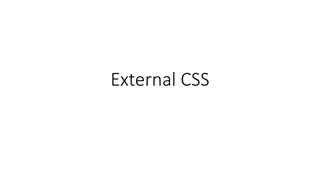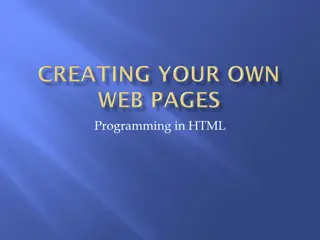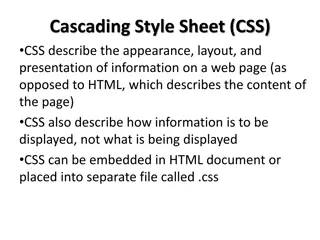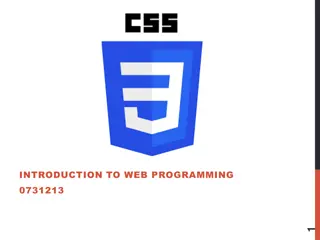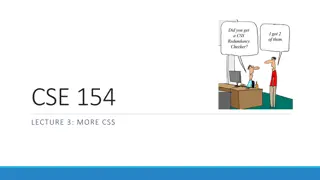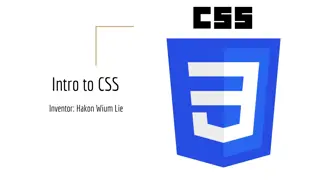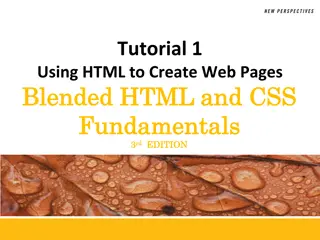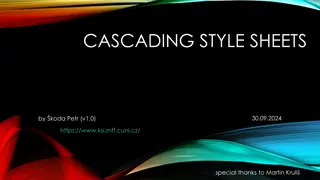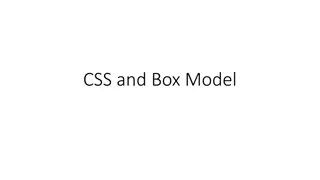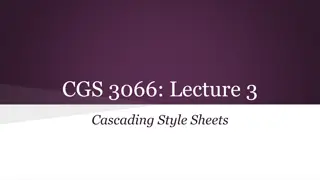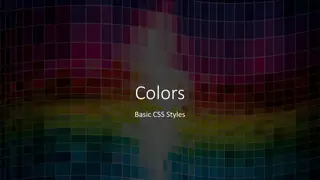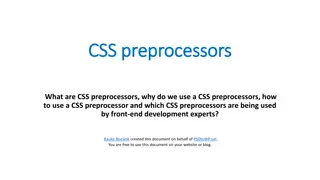Basics of HTML, CSS, and the Internet
Learn about the fundamental concepts of HTML, CSS, web servers, browsers, protocol layers, web addresses, key organizations governing the internet, a brief history of the internet, and popular web languages and technologies like HTML, CSS, JavaScript, PHP, Ajax, XML, and SQL.
Download Presentation

Please find below an Image/Link to download the presentation.
The content on the website is provided AS IS for your information and personal use only. It may not be sold, licensed, or shared on other websites without obtaining consent from the author.If you encounter any issues during the download, it is possible that the publisher has removed the file from their server.
You are allowed to download the files provided on this website for personal or commercial use, subject to the condition that they are used lawfully. All files are the property of their respective owners.
The content on the website is provided AS IS for your information and personal use only. It may not be sold, licensed, or shared on other websites without obtaining consent from the author.
E N D
Presentation Transcript
CSE 154 LECTURE 1: BASIC HTML AND CSS
The Internet Wikipedia: http://en.wikipedia.org/wiki/Internet a connection of computer networks using the Internet Protocol (IP) layers of communication protocols: IP TCP/UDP HTTP/FTP/POP/SMTP/SSH...
Web servers and browsers web server: software that listens for web page requests Apache Microsoft Internet Information Server (IIS) (part of Windows) web browser: fetches/displays documents from web servers Mozilla Firefox Microsoft Internet Explorer (IE) Apple Safari Google Chrome Opera
Layers of protocol Protocol: a set of rules governing the format of data sent IP address:
How do web addresses work? DNS: a set of servers that map written names to IP addresses Example: www.cs.washington.edu 128.208.3.88 many systems maintain a local cache called a hosts file URL: a basic URL:http://www.aw-bc.com/info/regesstepp/index.html ~~~~ ~~~~~~~~~~~~~ ~~~~~~~~~~~~~~~~~~~~~~~~~~ protocol host path
Who "runs" the internet? Internet Engineering Task Force (IETF): internet protocol standards Internet Corporation for Assigned Names and Numbers (ICANN): decides top-level domain names World Wide Web Consortium (W3C): web standards
Brief History began as a US Department of Defense network called ARPANET (1960s-70s) initial services: electronic mail, file transfer opened to commercial interests in late 80s WWW created in 1989-91 by Tim Berners-Lee popular web browsers released: Netscape 1994, IE 1995 Amazon.com opens in 1995; Google January 1996 Hamster Dance web page created in 1999
Web languages / technologies Hypertext Markup Language (HTML): used for writing web pages Cascading Style Sheets (CSS): stylistic info for web pages JavaScript: interactive and programmable web pages PHP Hypertext Processor (PHP): dynamically create pages on a web server Asynchronous JavaScript and XML (Ajax): accessing data for web applications eXtensible Markup Language (XML): metalanguage for organizing data Structured Query Language (SQL): interaction with databases
Structure of an HTML Structure of an HTML page page <!DOCTYPE html> <html> <head> </head> <body> </body> </html> information about the page page contents
Page title: Page title: <title> <title> describes the title of the web page <title>Chapter 2: HTML Basics</title> placed within the head of the page displayed in the web browser's title bar and when bookmarking the page
Paragraph: Paragraph: <p <p> > paragraphs of text (block) <p>You're not your job. You're not how much money you have in the bank. You're not the car you drive. You're not the contents of your wallet. You're not your khakis. You're the all-singing, all-dancing crap of the world.</p> You're not your job. You're not how much money you have in the bank. You're not the car you drive. You're not the contents of your wallet. You're not your khakis. You're the all-singing, all-dancing crap of the world. placed within the body of the page
Headings: Headings: <h1> <h1>, , <h2> <h2>, ..., , ..., <h6 <h6> > headings to separate major areas of the page (block) <h1>University of Whoville</h1> <h2>Department of Computer Science</h2> <h3>Sponsored by Micro$oft</h3> University of Whoville Department of Computer Science Sponsored by Micro$oft
Horizontal rule: Horizontal rule: < <hr hr> > a horizontal line to visually separate sections of a page (block) <p>First paragraph</p> <hr /> <p>Second paragraph</p> First paragraph Second paragraph should be immediately closed with />
Links: Links: <a <a> > links, or "anchors", to other pages (inline) <p> Search <a href="http://www.google.com/">Google</a> or our <a href="lectures.html">Lecture Notes</a>. </p> Search Google or our Lecture Notes. uses the href attribute to specify the destination URL can be absolute (to another web site) or relative (to another page on this site) anchors are inline elements; must be placed in a block element such as p or h1
Block and inline Block and inline elements elements block elements contain an entire large region of content examples: paragraphs, lists, table cells the browser places a margin of whitespace between block elements for separation inline elements affect a small amount of content examples: bold text, code fragments, images the browser allows many inline elements to appear on the same line must be nested inside a block element
Images: Images: < <img img> > inserts a graphical image into the page (inline) <img src="images/koalafications.jpg" alt="Koalified koala" /> the src attribute specifies the image URL HTML5 also requires an alt attribute describing the image
Line break: Line break: < <br br> > forces a line break in the middle of a block element (inline) <p>The woods are lovely, dark and deep, <br /> But I have promises to keep, <br /> And miles to go before I sleep, <br /> And miles to go before I sleep.</p> The woods are lovely, dark and deep, But I have promises to keep, And miles to go before I sleep, And miles to go before I sleep. Warning: Don't over-use br (guideline: >= 2 in a row is bad)
Phrase elements Phrase elements : : < <em em> >, , <strong> <strong> em: emphasized text (usually rendered in italic) strong: strongly emphasized text (usually rendered in bold) <p> HTML is <em>really</em>, <strong>REALLY</strong> fun! </p> HTML is really, REALLY fun! as usual, the tags must be properly nested for a valid page
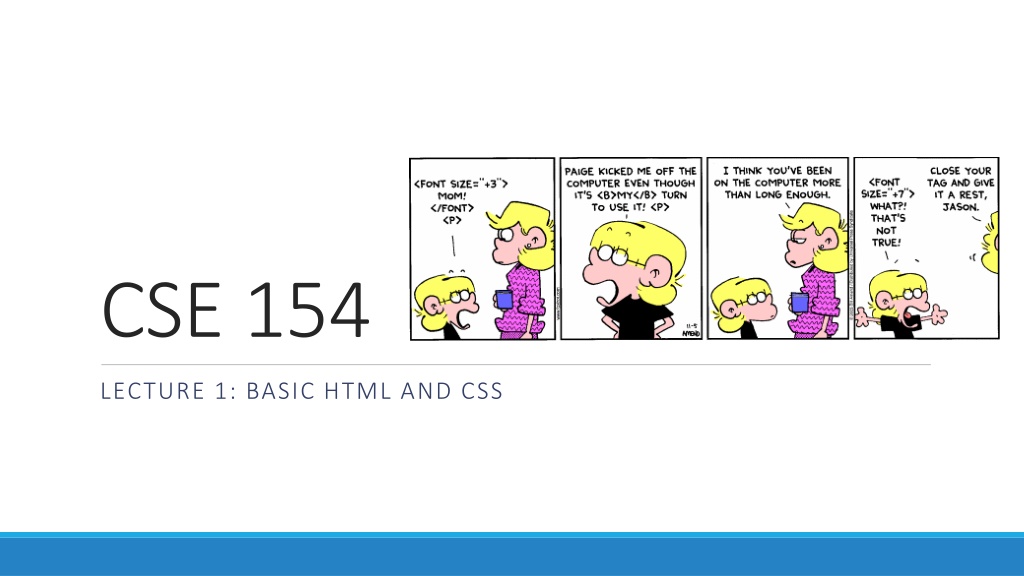
 undefined
undefined






